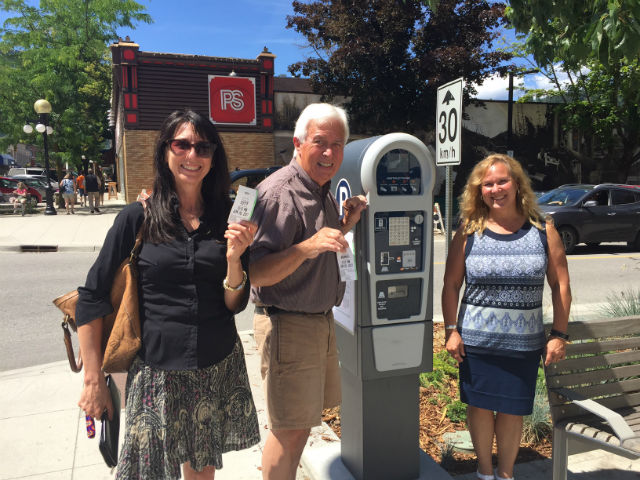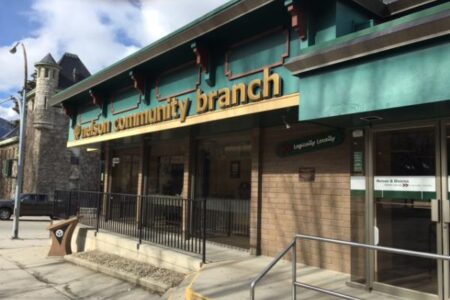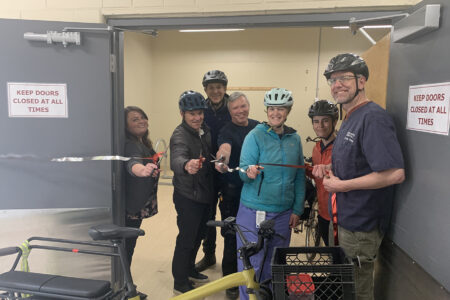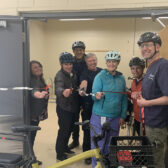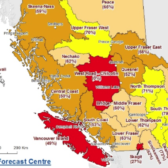City parking strategy creates 35 new spaces in the downtown; Hall Street PayStation now operational
The perplexing parking puzzle has prompted a potential project.
The city has begun to implement some aspects of its draft parking strategy in order to alleviate the parking pressure, including adding in over a score of new spaces, converting some parallel spots into angled parking.
As part of its interim strategy, the city has materialized 35 new stalls in the downtown through the conversion, while some parking meter times have been changed to meet the demand for parking times, including adding additional two-hour parking on Baker Street. “Parking is at a premium in some areas of our downtown and council is committed to working with the community to find ways to best utilize public and private parking,” said Mayor Deb Kozak.
“With limited off-street customer parking in our downtown, the pressure falls to on-street public parking. We will have to find a balance as there are a number of competing priorities.”
The city’s meter price has also risen from $1 per hour to $1.25.
A review of parking availability in the downtown began in 2016 — including paid meters, free two-hour parking zones, institutional and private parking, handicap stalls and loading zones.
It was determined that the average occupancy of public stalls throughout the entire downtown core parking area was 75 per cent, according to a city staff report, with key locations on Baker, Vernon, Victoria, Kootenay and Josephine Streets being well over 85 per cent during the hours between 10 a.m. to 4 p.m. Optimal parking stall occupancy is considered to be 85 per cent.
“With an average of 75 per cent utilization, Nelson’s downtown core is slightly below optimal use,” the report noted.
It was also noted in this review, that handicap stalls (50 per cent occupied) and institutional and private parking appeared under utilized, that loading zones were well used and the 15-minute meters were causing confusion for drivers.
As a result, the draft strategy is proposing a more efficient use of existing parking with new technology, the introduction of eight-hour commuter zones and converting parallel stalls to angled stalls wherever practical to increase the parking inventory.
One of the main aspects of the strategy includes creation of paid parking commuter zones to accommodate employees working in the downtown. Located outside the downtown, the commuter zones would be priced better than the existing downtown parking rates to encourage usage.
“This will provide employees with areas of relatively inexpensive parking where they don’t need to move their cars every couple of hours,” said Pam Mierau, city manager of development service, in her report to council.
As well, a number of areas throughout the downtown core have been identified as prime for conversion from parallel to angle parking, with some conversions scheduled for this year, and some for following years.
New angle parking stalls have been created on the 300 block of Cedar Street by the Nelson Curling Rink, on the 700 Baker Street north side in front of Remedy’s, on the 300 block of Victoria Street below the Nelson Public Library and on Lake Street by Midas.
A few new stalls have been created in front of Pharmsave, the 600 block of Baker Street and on the south side of Baker Street — all now two-hour parking meters — while angle parking on north side of Baker Street is now one-hour parking meters.
The catalog of free parking in lower Uphill could be on the endangered list as the city looks to create a demand for paid parking, and encourage other modes of transportation like transit or bicycles. City staff had expressed a desire to council “to explore the feasibility of converting some of this free parking” to paid parking.
The Luke II PayStation has been installed on Hall Street, servicing the 400 and 500 blocks. Parking on these two blocks will require individuals to pay via the PayStation. The PayStation will allow users to pay via coin or credit card (including tap and pay credit cards) and eventually will also allow parking to be paid via smartphone.
Features of the new PayStation include:
- parking is paid by licence plate number,
- users do not have to return to their car to display the parking receipt, and,
- users can extend their parking time via text/phone.
According to a city press release, if the PayStation pilot is successful additional pay stations will be added within the downtown and waterfront areas, with individuals eventually able to use the stations to pay for parking at metered stalls.
There could be more incorporation of off-street parking, since it was identified by city staff that there was “unoccupied private or institutional parking within the downtown core throughout the day and during weekends and evenings.” It was felt there could be opportunities to better utilize this parking.
The parking strategy was developed as part of the city’s 2015-2018 Strategic Plan, using an “internal parking committee” to develop the draft strategy. It was presented in a public meeting on May 15 with further consultation expected with stakeholders.
The consultation will include groups that may be impacted by parking changes including, the business community, employees, delivery drivers, motorists with handicap designations, those that license (rent) city parking stalls (street patios, food vending, other private business uses), private or institutional parking owners and residents in the two-hour parking zones.
The draft strategy and background materials can be found at www.nelson.ca under Publications and Reports.



